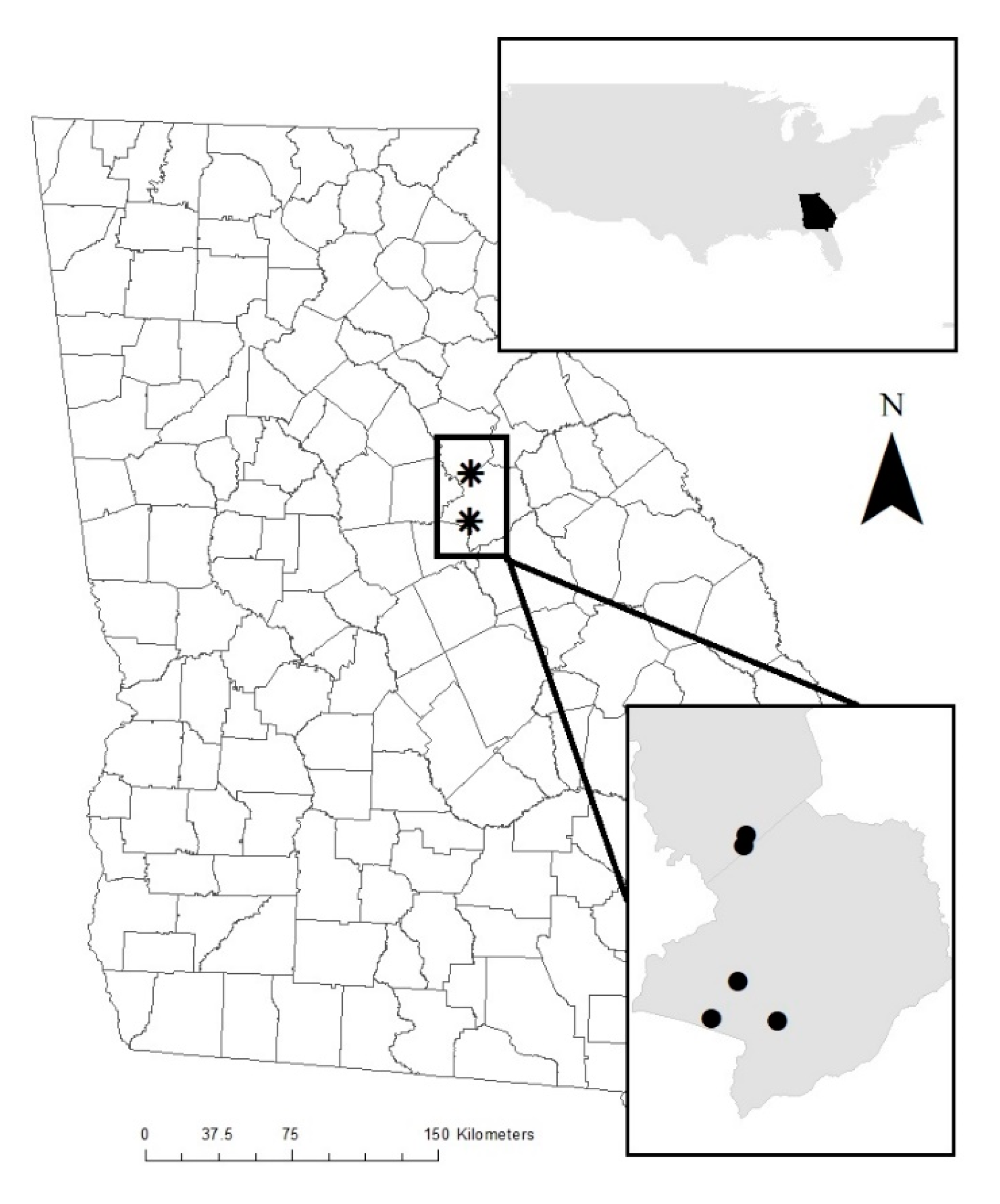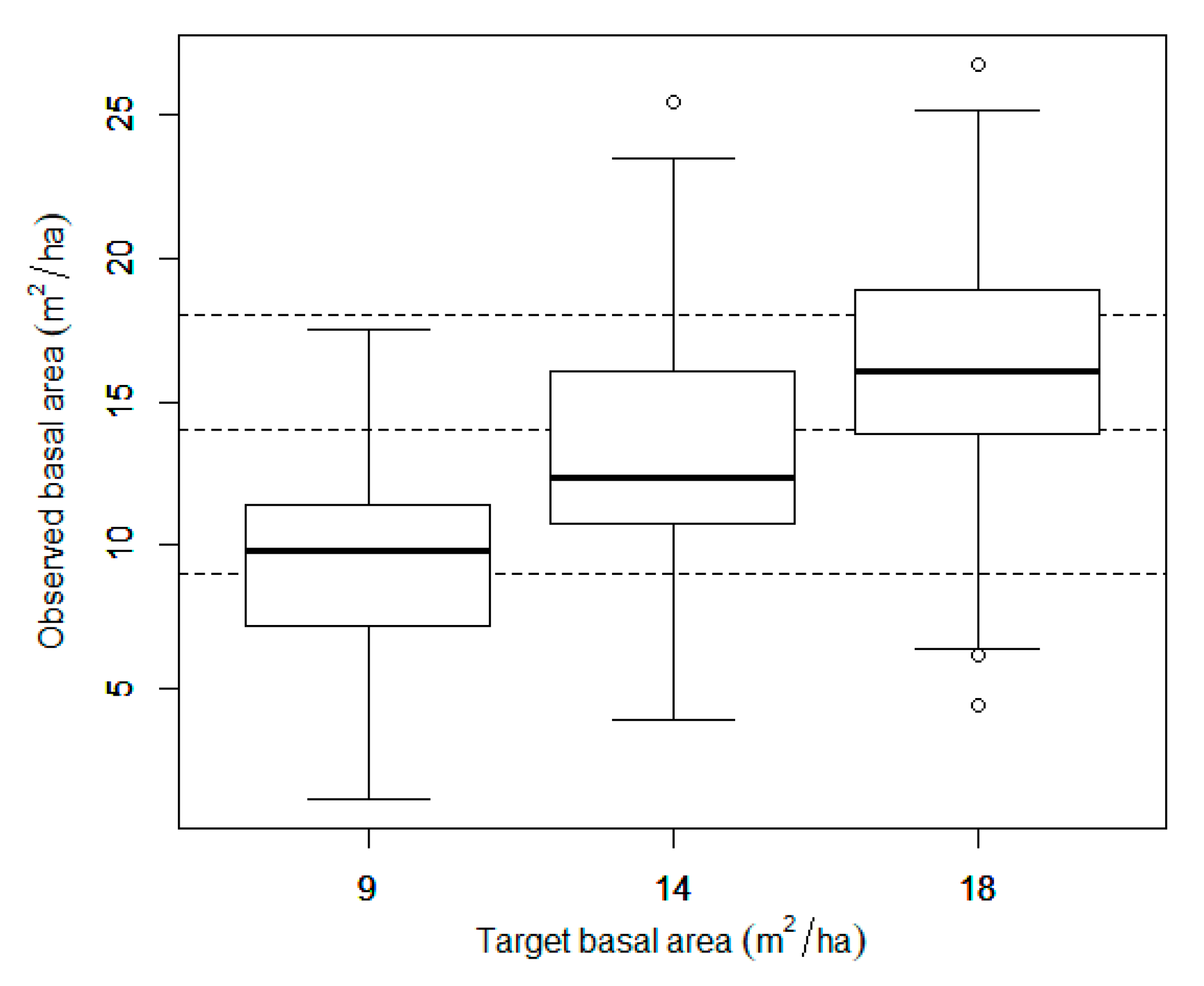Accuracy and Precision of Commercial Thinning to Achieve Wildlife Management Objectives in Production Forests
Abstract
1. Introduction
2. Materials and Methods
3. Results
4. Discussion
Author Contributions
Funding
Institutional Review Board Statement
Informed Consent Statement
Data Availability Statement
Acknowledgments
Conflicts of Interest
References
- Howard, J.L.; Liang, S. U.S. Timber Production, Trade, Consumption, and Price Statistics, 1965–2017; Research Paper FPL-RP-701; U.S. Department of Agriculture, Forest Service, Forest Products Laboratory: Madison, WI, USA, 2019; 96p. [Google Scholar]
- Wear, D.N.; Greis, J.G. The Southern Forest Futures Project: Summary Report; U.S. Department of Agriculture, Forest Service, Northern Research Station: Asheville, NC, USA, 2012; Volume 168, pp. 1–54. [Google Scholar]
- Brockway, D.G.; Lewis, C.E. Influence of deer, cattle grazing and timber harvest on plant species diversity in a longleaf pine bluestem ecosystem. For. Ecol. Manag. 2003, 175, 49–69. [Google Scholar] [CrossRef]
- Noss, R.F.; Platt, W.J.; Sorrie, B.A.; Weakley, A.S.; Means, D.B.; Costanza, J.; Peet, R.K. How global biodiversity hotspots may go unrecognized: Lessons from the North American Coastal Plain. Divers. Distrib. 2015, 21, 236–244. [Google Scholar] [CrossRef]
- Jones, J.C.; Dorr, B. Habitat associations of gopher tortoise burrows on industrial timberlands. Wildl. Soc. Bull. 2004, 32, 456–464. [Google Scholar] [CrossRef]
- Frost, C.C. Four centuries of changing landscape patterns in the longleaf pine ecosystem. In Proceedings of the Tall Timbers Fire Ecology Conference, Tallahassee, FL, USA, 3–6 November 1993; Available online: https://talltimbers.org/information-resources-fire-ecology-conference-proceedings/ (accessed on 29 March 2021).
- Landers, J.L.; Van Lear, D.H.; Boyer, W.D. The longleaf pine forests of the Southeast: Requiem or renaissance? J. For. 1995, 93, 39–44. [Google Scholar]
- Hedrick, L.D.; Bukenhofer, G.A.; Montague, W.G.; Pell, W.F.; Guldin, J.M. Shortleaf-pine-bluestem restoration in the Ouachita National Forest. In Shortleaf Pine Restoration and Ecology in the Ozarks: Proceedings of A Symposium; General Technical Report NRS-P-15; U.S. Department of Agriculture, Forest Service, Northern Research Station: Newtown Square, PA, USA, 2006. [Google Scholar]
- Alavalapati, J.R.; Stainback, G.A.; Carter, D.R. Restoration of the longleaf pine ecosystem on private lands in the US South: An ecological economic analysis. Ecol. Econ. 2002, 40, 411–419. [Google Scholar] [CrossRef]
- Campbell, T.N.; Jones, P.D.; Demarais, S.; Ezell, A.W. Vegetation communities in intensively established loblolly pine planta-tions at crown closure. J. For. 2015, 113, 298–307. [Google Scholar]
- Blair, R.M. Timber stand density influences food and cover. In White-tailed Deer in the Southern Forest Habitat: Proceedings of A Symposium; Southern Forest Experiment Station, Forest Service, U.S. De-partment of Agriculture: New Orleans, LA, USA, 1969. [Google Scholar]
- Brennan, L.A. How can we reverse the Northern Bobwhite population decline? Wildl. Soc. Bull. 1991, 19, 544–555. [Google Scholar]
- Miller, D.A.; Wigley, T.B.; Miller, K.V. Managed forests and conservation of terrestrial biodiversity in the southern United States. J. For. 2009, 107, 197–203. [Google Scholar]
- Hedman, C.W.; Grace, S.L.; King, S.E. Vegetation composition and structure of southern coastal plain pine forests: An ecolog-ical comparison. For. Ecol. Manag. 2000, 134, 233–247. [Google Scholar] [CrossRef]
- Iglay, R.B.; Leopold, B.D.; Miller, D.A. Vegetation responses to fire and herbicide in intensively managed, mid-rotation pine. For. Ecol. Manag. 2014, 328, 69–78. [Google Scholar] [CrossRef]
- Blair, R.M.; Enghardt, H.G. Deer forage and overstory dynamics in a loblolly pine plantation. J. Range Manag. 1976, 29, 104. [Google Scholar] [CrossRef]
- Conroy, M.J.; Oderwald, R.G.; Sharik, T.L. Forage production and nutrient concentrations in thinned loblolly pine plantations at crown closure. J. For. 1982, 46, 719–727. [Google Scholar]
- Peitz, D.G.; Tappe, P.A.; Shelton, M.G.; Sams, M.G. Deer browse response to pine-hardwood thinning regimes in southeast-ern Arkansas. South J. Appl. For. 1999, 23, 16–20. [Google Scholar] [CrossRef]
- Verschuyl, J.S.; Riffell, D.; Miller, D.A.; Wigley, T.B. Biodiversity response to intensive biomass production from forest thin-ning in North American forests—A meta-analysis. For. Ecol. Manag. 2011, 261, 221–232. [Google Scholar] [CrossRef]
- Aresco, M.J.; Guyer, C. Burrow Abandonment by gopher tortoises in slash pine plantations of the Conecuh National Forest. J. Wildl. Manag. 1999, 63, 26. [Google Scholar] [CrossRef]
- Walters, J.R.; Daniels, S.J.; Carter, J.H.; Doerr, P.D. Defining quality of red-cockaded woodpecker foraging habitat based on habitat use and fitness. J. Wildl. Manag. 2002, 66, 1064. [Google Scholar] [CrossRef]
- Little, I.T.; Wellendorf, S.D.; Palmer, W.E.; Carroll, J.P. Effects of timber density on Northern Bobwhite autumn abundance. Natl. Quail Symp. Proc. 2009, 6, 178–183. [Google Scholar]
- Masters, R.E.; Robertson, K.; Palmer, W.E.; Cox, J.; McGorty, K.; Green, L.; Ambrose, C. Red Hills Forest Stewardship Guide; Tall Timbers Research, Inc.: Tallahassee, FL, USA, 2007. [Google Scholar]
- Copeyon, C.K. A technique for constructing cavities for the Red-Cockaded Woodpecker. Wildl. Soc. Bull. 1990, 18, 303–311. [Google Scholar]
- Huang, C.; Kronrad, G.D. Financially optimal thinning and final harvest schedules for loblolly pine plantations on nonindus-trial private forestland in east Texas. South J. Appl. For. 2002, 26, 13–17. [Google Scholar]
- Maggard, A.; Barlow, B. Costs and Trends of Southern Forestry Practices; Alabama Cooperative Extension System: Montgomery, AL, USA, 2018.
- Arguez, A.; Durre, I.; Applequist, S.; Vose, R.S.; Squires, M.F.; Yin, X.; Heim, R.R., Jr.; Owen, T.W. NOAA’s 1981–2010 U.S. climate normal: An overview. Bull. Am. Meteorol. Soc. 2012, 93, 1687–1697. [Google Scholar] [CrossRef]
- Natural Resources Conservation Service (NRCS); United States Department of Agriculture. Digital Raster Graphic Mosaic of Greene/Hancock Counties, Georgia. Available online: https://datagateway.nrcs.usda.gov/GDGOrder.aspx (accessed on 29 March 2021).
- Natural Resources Conservation Service (NRCS); Soil Survey Staff; United States Department of Agriculture. Web Soil Survey. Available online: https://websoilsurvey.sc.egov.usda.gov/ (accessed on 29 March 2021).
- Pinheiro, J.; Bates, D.; DebRoy, S.; Sarjar, D.; R Core Team. nlme: Linear and Nonlinear Mixed Effects Models. R Package Version 3.1. Available online: https://cran.r-project.org/package=nlme (accessed on 29 March 2021).
- R Core Team. R: A Language and Environment for Statistical Computing; R Foundation for Statistical Computing: Vienna, Austria, 2018; Available online: https://www.R-project.org (accessed on 29 March 2021).
- Guo, Y.; Shelton, M.G. Canopy light transmittance in natural stands on upland sites in Arkansas. In Proceedings of the Southern Silvicultural Research Conference, Asheville, NC, USA, 25–27 February 1998. [Google Scholar]
- United States Fish and Wildlife Service (USFWS). Recovery Plan for the Red-Cockaded Woodpecker (Picoides borealis); U.S. Fish and Wildlife Service: Atlanta, GA, USA, 1985.
- Porter, M.L.; Labisky, R.F. Home range and foraging habitat of red-cockaded woodpeckers in Northern Florida. J. Wildl. Manag. 1986, 50, 239. [Google Scholar] [CrossRef]
- Gulf Coastal Plains and Ozarks Landscape Conservation Cooperative Network. Available online: https://gcpolcc.org/resource/gcpo-lcc-draft-integrated-science-agenda (accessed on 29 March 2021).
- McIntyre, R.K.; Conner, L.M.; Jack, S.B.; Schlimm, E.M.; Smith, L.L. Wildlife habitat condition in open pine woodlands: Field data to refine management targets. For. Ecol. Manag. 2019, 437, 282–294. [Google Scholar] [CrossRef]
- Greene, R.E.; Iglay, R.B.; Evans, K.O. Providing open forest structural characteristics for high conservation priority wildlife species in southeastern U.S. pine plantations. For. Ecol. Manag. 2019, 453, 117594. [Google Scholar] [CrossRef]
- Sutton, W.B.; Wang, Y.; Schweitzer, C.J. Amphibian and reptile responses to thinning and prescribed burning in mixed pine-hardwood forests of northwestern Alabama, USA. For. Ecol. Manag. 2013, 295, 213–227. [Google Scholar] [CrossRef]
- Tinkham, W.T.; Dickinson, Y.; Hoffman, C.M.; Battaglia, M.A.; Ex, S.; Underhill, J. Visualization of Heterogeneous Forest Structures Following Treatment in the Southern Rocky Mountains; General Technical Report RMRS-GTR-365; United States Forest Service, United States Department of Agriculture, Rocky Mountain Research Station: Fort Collins, CO, USA, 2017.
- Schwilk, D.W.; Keeley, J.E.; Knapp, E.E.; McIver, J.; Bailey, J.D.; Fettig, C.J.; Fiedler, C.E.; Harrod, R.J.; Moghaddas, J.J.; Outcalt, K.W.; et al. The national Fire and Fire Surrogate study: Effects of fuel reduction methods on forest vegetation structure and fuels. Ecol. Appl. 2009, 19, 285–304. [Google Scholar] [CrossRef] [PubMed]
- McGuire, J.P.; Mitchell, R.J.; Moser, E.B.; Pecot, S.D.; Gjerstad, D.H.; Hedman, C.W. Gaps in a gappy forest: Plant resources, longleaf pine regeneration, and understory response to tree removal in longleaf pine savannas. Can. J. For. Res. 2001, 31, 765–778. [Google Scholar] [CrossRef]
- Outcalt, K.W. Restoring structure and composition of longleaf pine ecosystems of the Gulf Coastal Plains. In Proceedings of the 5th Longleaf Alliance Regional Conference 2005, Hattiesburg, MS, USA, 12–15 October 2004. [Google Scholar]
- Van Lear, D.H.; Carroll, W.; Kapeluck, P.; Johnson, R. History and restoration of the longleaf pine-grassland ecosystem: Implications for species at risk. For. Ecol. Manag. 2005, 211, 150–165. [Google Scholar] [CrossRef]


| Model | β | SE | LCL | UCL | p-Value |
|---|---|---|---|---|---|
| Intercept 1 | −3.36 | 1.53 | −6.36 | −0.36 | 0.03 |
| Medium 2 | 1.78 | 0.62 | 0.36 | 3.20 | 0.02 |
| Low 3 | 2.76 | 0.62 | 1.33 | 4.19 | 0.002 |
| Pre-marked 4 | 1.39 | 1.92 | −4.69 | 7.46 | 0.52 |
| Model | β | SE | LCL | UCL | p-Value |
|---|---|---|---|---|---|
| Intercept 1 | 29.24 | 4.77 | 18.75 | 39.73 | <0.001 |
| Medium 2 | 0.18 | 5.50 | −11.93 | 12.29 | 0.97 |
| Low 3 | 9.28 | 5.50 | −2.83 | 21.39 | 0.12 |
| Pre-marked 4 | −12.44 | 4.59 | 0.28 | 8.92 | 0.02 |
Publisher’s Note: MDPI stays neutral with regard to jurisdictional claims in published maps and institutional affiliations. |
© 2021 by the authors. Licensee MDPI, Basel, Switzerland. This article is an open access article distributed under the terms and conditions of the Creative Commons Attribution (CC BY) license (http://creativecommons.org/licenses/by/4.0/).
Share and Cite
Keene, K.; Gulsby, W.; Colter, A.; Miller, D.; Johannsen, K.; Miller, K.; Martin, J. Accuracy and Precision of Commercial Thinning to Achieve Wildlife Management Objectives in Production Forests. Forests 2021, 12, 411. https://doi.org/10.3390/f12040411
Keene K, Gulsby W, Colter A, Miller D, Johannsen K, Miller K, Martin J. Accuracy and Precision of Commercial Thinning to Achieve Wildlife Management Objectives in Production Forests. Forests. 2021; 12(4):411. https://doi.org/10.3390/f12040411
Chicago/Turabian StyleKeene, Kent, William Gulsby, Allison Colter, Darren Miller, Kristina Johannsen, Karl Miller, and James Martin. 2021. "Accuracy and Precision of Commercial Thinning to Achieve Wildlife Management Objectives in Production Forests" Forests 12, no. 4: 411. https://doi.org/10.3390/f12040411
APA StyleKeene, K., Gulsby, W., Colter, A., Miller, D., Johannsen, K., Miller, K., & Martin, J. (2021). Accuracy and Precision of Commercial Thinning to Achieve Wildlife Management Objectives in Production Forests. Forests, 12(4), 411. https://doi.org/10.3390/f12040411






